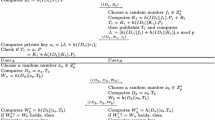Abstract
Ideal function is the fundamental component in the universally composable security model. However, the certification ideal function defined in the universally composable security model realizes the identity authentication by binding identity to messages and the signature, which fails to characterize the special security requirements of anonymous authentication with other kind of certificate. Therefore, inspired by the work of Marten, an anonymous hash certification ideal function and a more universal certificate CA model are proposed in this paper. We define the security requirements and security notions for this model in the framework of universal composable security and prove in the plain model (not in the random-oracle model) that these security notions can be achieved using combinations of a secure digital signature scheme, a symmetrical encryption mechanism, a family of pseudorandom functions, and a family of one-way collision-free hash functions. Considering the limitation of wireless environment and computation ability of wireless devices, this anonymous Hash certification ideal function is realized by using symmetry primitives.
Similar content being viewed by others
References
Martin A, Phillip R. Reconciling two views of cryptography. J Crypt, 2002, 15(2): 103–127
Wenbo M, Modern Cryptography: Theory and Practice. Prentice-Hall, PTR, 2004
Bellare M, Rogaway P. Random oracles are practical: a paradigm for designing efficient protocols. In: First ACM Conference on Computer and Communications Security. New York: ACM Press, 1993, 62–73
Beaver D. Foundations of secure interactive computing. In: J Feigenbaum, ed. Advances in Cryptology-Crypto’91. LNCS 576. Berlin: Springer-Verlag Press. 1991, 377–391
Andrew C, Qizhi Y. Protocols for secure computations (extended abstract). In: 23rd Annual Symposium on Foundations of Computer Science, November 1982, 160–164
Ran C, Hugo K. Analysis of key exchange protocols and their use for building secure channels. In: Pfitzmann B, ed. Advances in Cryptology—EUROCRYPT 2001. LNCS 2045. Berlin: Springer-Verlag Press, 2001, 453–474
Ran C, Hugo K. Security analysis of IKE’s signature-based key exchange protocol. Advances in Cryptology — Crypto 2002, August 2002, 143–161
Ran C, Universally composable security: A new paradigm for cryptographic protocols. In: 42th IEEE Annual Symposium on Foundations of Computer Science, 2001, 136–145
Birgit P, Michael W. A model for asynchronous reactive systems and its application to secure message transmission. IEEE Symposium on Security and Privacy, Oakland, California, May 2001, 184–200
Yehuda L. Composition of secure multi-party protocols — A comprehensive study. Lecture Notes in Computer Science. Berlin: Springer-Verlag, 2003. 2815
Yehuda L. General composition and universal composability in secure multi-party computation. In: Proceedings of the 44th Annual IEEE Symposium on Foundations of Computer Science, 2003. 394–403
Ran C. Universally composable two-party and muti-party secure computation. In: 34th STOC. New York: ACM Press, 2002. 494–503
Ji Q G, Feng D G. Towards analyzing some kinds of critically formal models for network security protocols (in Chinese). Chi J Comp, 2005, (7): 128–141
Ran C, Marc F. Universally Composable Commitments. Lecture Notes in Computer Science, 2139. 2001, 19–28
Ran C, Hugo K. Universally composable notions of key exchange and secure channels. Theory and Application of Cryptographic Techniques, Lecture notes in computer science, Berlin: Springer, 2002. 337–351
Ran C, Shai H, Jonathan K, et al. Universally composable password-based key exchange. Eurocrypt, 2005, 404–421
Ivan D, Jesper B N. Perfect hiding and perfect binding universally composable commitment schemes with constant expansion factor. In CRYPTO, 2002, 581–596
Mateus P, Mitchell J, Scedrov C. A composition of cryptographic protocols in a probabilistic polynomial-time process calculus. In: 14th International Conference on Concurrency Theory, LNCS 2761. Berlin: Springer-Verlag, 2003. 327–349
Ran C, Hugo K. Universally Composable Symbolic Analysis of Cryptographic Protocols (The Case of Encryption-based Mutual Authentication and Key-Exchange). DIMACS workshop on protocols security analysis, 2004
Manoj P, Amit S. New notions of Security: Achieving universal composability without trusted setup. In: STOC’04: Proceedings of the 36th Annual ACM Symposium on Theory of Computing. New York: ACM Press, 2004. 242–251
Oded G, Foundations of Cryptography (Fragments of a book). Weizmann Inst. of Science, 1995
Shafi G, Silvio M, Ron L R. A digital signature scheme secure against adaptive chosen-message attacks. JOC, 1988, 17(2): 281–308
Ralph C M. Protocols for public key cryptosystems. In: IEEE Symposium on Security and Privacy. Oakland: IEEE Computer Society Press, 1980. 122–133
Ran C, Universally composable signature, certification, and authentication. In: 17th IEEE Computer Security Foundations Workshop (CSFW), 2004, 219–245
Marten T. A universally composable scheme for electronic cash. Indocrypt, 2005, 347–360
Michael B, Dennis H. How to break and repair a universally composable signature functionality. In: Information Security Conference-ISC, LNCS 3225, 2004, 61–74
Author information
Authors and Affiliations
Corresponding author
Additional information
Supported by the National Natural Science Foundation of China (Grant Nos. 90204012, 60573035, and 60573036), and by the MIC of Korea, under the ITRC support program supervised by the IITA (IITA-2006-C1090-0603-0026)
Rights and permissions
About this article
Cite this article
Zhang, F., Ma, J. & Moon, S. Universally composable anonymous Hash certification model. SCI CHINA SER F 50, 440–455 (2007). https://doi.org/10.1007/s11432-007-0029-2
Received:
Accepted:
Issue Date:
DOI: https://doi.org/10.1007/s11432-007-0029-2




